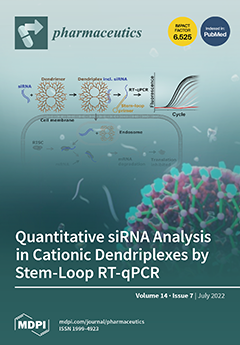Purpose: The C-X-C chemokine receptor 4 (CXCR4) is highly expressed in many subtypes of cancers, notably in several kidney-based malignancies. We synthesized, labeled, and assessed a series of radiotracers based on a previous high contrast PET imaging radiopharmaceutical [
68Ga]Ga-BL02, with modifications
[...] Read more.
Purpose: The C-X-C chemokine receptor 4 (CXCR4) is highly expressed in many subtypes of cancers, notably in several kidney-based malignancies. We synthesized, labeled, and assessed a series of radiotracers based on a previous high contrast PET imaging radiopharmaceutical [
68Ga]Ga-BL02, with modifications to its linker and metal chelator, in order to improve its tumor-to-kidney contrast ratio. Methods: Based on the design of BL02, a piperidine-based cationic linker (BL06) and several anionic linkers (tri-Aad (BL17); tri-D-Glu (BL20); tri-Asp (BL25); and tri-cysteic acid (BL31)) were substituted for the triglutamate linker. Additionally, the DOTA chelator was swapped for a DOTAGA chelator (BL30). Each radiotracer was labeled with
68Ga and evaluated in CXCR4-expressing Daudi xenograft mice with biodistribution and/or PET imaging studies. Results: Of all the evaluated radiotracers, [
68Ga]Ga-BL31 showed the most promising biodistribution profile, with a lower kidney uptake compared to [
68Ga]Ga-BL02, while retaining the high imaging contrast capabilities of [
68Ga]Ga-BL02. [
68Ga]Ga-BL31 also compared favorably to [
68Ga]Ga-Pentixafor, with superior imaging contrast in all non-target organs. The other anionic linker-based radiotracers showed either equivocal or worse contrast ratios compared to [
68Ga]Ga-BL02; however, [
68Ga]Ga-BL25 also showed lower kidney uptake, as compared to that of [
68Ga]Ga-BL02. Meanwhile, [
68Ga]Ga-BL06 had high non-target organ uptake and relatively lower tumor uptake, while [
68Ga]Ga-BL30 showed significantly increased kidney uptake and similar tumor uptake values. Conclusions: [
68Ga]Ga-BL31 is an optimized CXCR4-targeting radiopharmaceutical with lower kidney retention that has clinical potential for PET imaging and radioligand therapy.
Full article






